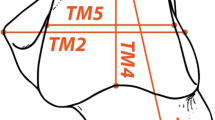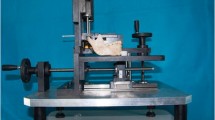Summary
Seventeen measuring parameters were used to characterize 197 mandibles (109 males, 88 females) taken from the corpses of people 20–80 years of age from the Rhine-Main-Neckar area. The representative measuring parameters and discriminating functions of intact lower jaws and lower jaw fragments of most frequent fracture types were determined in this practice group by means of discriminating analysis. In the present research material it was possible to determine sex accurately from an intact lower jaw bone in 82.6% (m) and 79.5% (f) of the cases. Furthermore, our results show clearly that sex may even be determined from lower jaw fragments. The classification was correct, depending on the type of fragment, in 72.5%–81.7% (m) and 71.6%–79.5% (f) of the cases.
Zusammenfassung
Einhundertsiebenundneunzig Unterkiefer (109 männlich, 88 weiblich) der Altersgruppe 20–80 Jahre aus dem Rhein-Main-Neckargebiet wurden durch je 17 Meßparameter charakterisiert.
An dieser Trainingsgruppe (insgesamt 3743 Daten) wurden durch Diskriminanzanalyse die repräsentativen Meßstrecken und die Diskriminanzfunktionen für vollständige Unterkiefer und für Unterkieferfragmente häufiger Frakturtypen bestimmt. Am vorliegenden Untersuchungsgut war anhand des vollständigen Unterkieferknochens eine zutreffende Geschlechtsbestimmung in 82,6% (männlich) und 79,5% (weiblich) möglich.
Unsere Ergebnisse zeigen weiterhin eindeutig, daß sich auch Unterkieferfragmente zur Geschlechtsbestimmung eignen. Die richtige Klassifikation erfolgte je nach Fragmenttyp in 72,5–81,7% (männlich) und in 71,6–79,5% (weiblich) der Fälle.
Similar content being viewed by others
Literatur
Giles E, Elliot O (1963) Sex determination by discriminant function analysis of crania. Am J Phys Anthropol 21:53–68
Giles E (1964) Sex determination by discriminant function analysis of the mandible. Am J Phys Anthropol 22:129–135
Hanihara K (1959) Sex diagnosis of Japanese skulls and scapulae by means of discriminant function. J Anthropol Soc Nippon 67:191–197
Hanihara K, Kimura K, Minamidate T (1964) The sexing of Japanese skeleton by means of discriminant function. Nihon Hôigaku Zassi (Japanese J Forensic Med) 18:107–114
Krogman WM (1962) The human skeleton in forensic medicine. Charles C. Thomas, Springfield, USA
Martin ES (1936) A study of an Egyptian series of mandibles, with special reference to mathematical methods of sexing. Biometrika 28:149–178
Martin-Saller (1957) Lehrbuch der Anthropologie, 3. Aufl, BdI. Gustav Fischer, Stuttgart
Steel FLD (1962) The sexing of long bones, with reference to the St. Bridge's series of identified skeletons. J Royal Anthropol Inst 92:212–222
Stewart TD (ed) (1952) Hrdlička's practical anthropometry, 4th ed. Wistar Institute of Anatomy and Biology. Philadelphia
Endris R, Pötsch-Schneider L (1984) Sex determination of lower jaw fragments. (In press)
Author information
Authors and Affiliations
Rights and permissions
About this article
Cite this article
Pötsch-Schneider, L., Endris, R. & Schmidt, H. Diskriminanzanalyse zur Geschlechtsbestimmung an Unterkieferknochen. Z Rechtsmed 94, 21–30 (1985). https://doi.org/10.1007/BF00200520
Received:
Issue Date:
DOI: https://doi.org/10.1007/BF00200520




